I like pigs. They always seem to have a smile on their face, and not too long ago, I discovered that they wag those crazy tails of theirs. But I love more what pigs can become. Belly meat becomes bacon. Shoulder becomes tender carnitas. And now … skin becomes pork rinds.
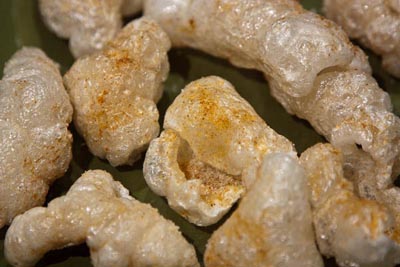
You may or may not remember last Christmas, I made the family a couple varieties of bacon (among other things) for the holidays. Because I couldn’t get the pork belly I preferred, I wound up going to a local meat market where lo and behold, the belly came with the skin still intact (complete with nipples).
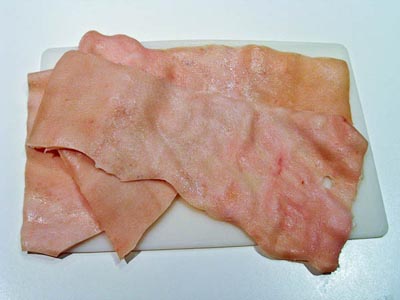
Raw pig skin
I wanted badly at that moment to turn that pig skin into lovely, fluffy pork rinds, but get this: no one knew how to do it. I grew up in the Midwest … around farmers … no one I talked to back home seemed to know the answer. I searched the net for suitable preparations for pork rinds, fried pig skin, or chicharrones, but came up with nothing. Instead of pork rind goodness, I sadly packaged up all my pig skin and stowed it in the freezer till I could figure out what to do with it.
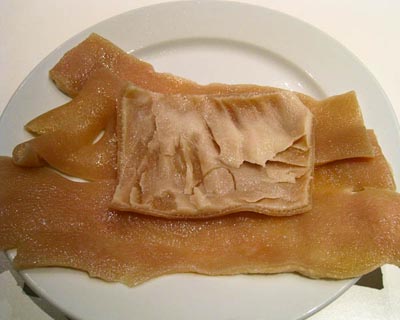
Pig skin after boiling - note the evidence of my exquisite butchering technique
In the end, I stumbled across the answer by accident. My habit when we go to the bookstore and I really don’t want to be there is to hide in the cookbook section the entire time. On a recent visit, I happened across a copy of Momofuku, and in flipping through the pages marveling over the beautiful noodles and pork belly buns, found a method for producing chicharrones. It would take some time, but nothing I couldn’t replicate at home. No need to spend money on a cookbook, right?
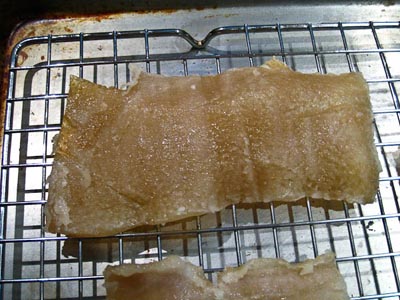
Pig skin with most of fat cut off, ready to be slowly dried
I recited the rough method all the way home. When I got there, naturally, I had to feed the cats and tidy up the kitchen, and then I remembered that I wanted to finish the book I was reading … and then it was a week later and I couldn’t quite remember how to turn my pig skins into pork rinds. Luckily, I had better search terms at my disposal, and found the Momofuku for Two website and the site’s author, Steph’s take on the chicharrones preparation I had forgotten. It filled the gaps in my memory nicely.
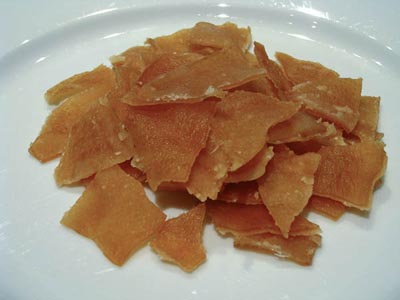
Dried pig skin chips
(For what it’s worth, I couldn’t stop thinking about that damn bowl of ramen and wound up buying the Momofuku cookbook anyway. If I can manage to gather all the ingredients, I’ll be trying my hand at that one soon.)
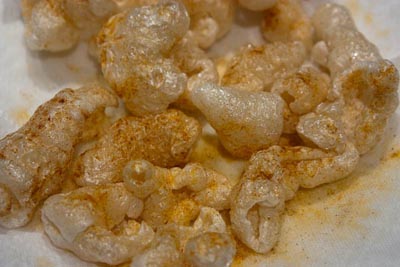
Finished pork rinds
PORK RINDS (aka Chicharrones)
Step one: Boil pig skin for about an hour. The kitchen will take on an aroma that’s either lovely or gag-worthy depending on your degree of pork affinity.
Step two: Chill the skin completely. I laid mine out on a cooling rack set in a half sheet pan and stuck it in the refrigerator overnight (though it really shouldn’t take that long).
Step three: Remove all the fat from the skin. I remember the Momofuku book advising scraping away the fat with a spoon, but I wound up just cutting mine away with a sharp paring knife. I don’t know which way is superior, but I did find cutting it away with a knife to be fairly simple. It seemed like the skin / fat divide became much clearer after the boiling process.
Step four: Dry the skin thoroughly. In the book, a dehydrator is called for, but I had planned on just using a low oven and seeing what happened. Luckily, Steph at Momofuku for Two went the same route with good results, so I got to approach the problem with a level of confidence. I left the skins on the same cooling rack-half sheet pan apparatus that I had cooled them on and stuck the whole thing into a 170 degree (F) oven for many hours. I’m sorry, I’m not sure how many, but lots. I would guess at least ten, maybe more. Dry the skin until it snaps when bent. All flexibility should be gone. Break them into much smaller bits than you think you’ll need because they will expand mightily.
Step five: Fry till puffy. First heat canola oil (or some other high smoke point oil) to somewhere between 350 and 400 degrees (F). I know that’s not very precise, but I kept a thermometer in the oil the whole time I was frying, and it wavered all over the place and didn’t really seem to make too much difference. Don’t add more than two or three pig skin pieces at a time. They cook quickly (a matter of seconds), and they puff so impressively that you run the risk of running out of room in the pan. Watch them carefully, the hard brownish skin should turn fluffy and white all the way around. It may require holding the skin under the oil for the entire skin to fry correctly and leave no hard spots.
Note: If you’re comfortable using chopsticks, I found a pair of those to be the best tool for manipulating the pork rind once it was in the oil and for removing it with a minimum of carryover oil.
Finally, season the pork rinds. The seasoning will stick best if this is done as soon as they’re pulled from the oil. Chang calls for togarashi 7-spice powder in the Momofuku cookbook. I didn’t have that on hand, so I used the same seasoning blend I use for my freshly popped popcorn. It was delicious.
Note: If you don’t consume all your freshly fried pork rinds in one sitting, cool to room temperature and seal them in an airtight container. They appear to go stale rapidly.